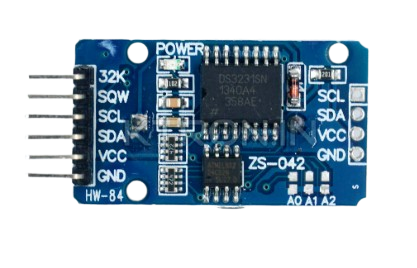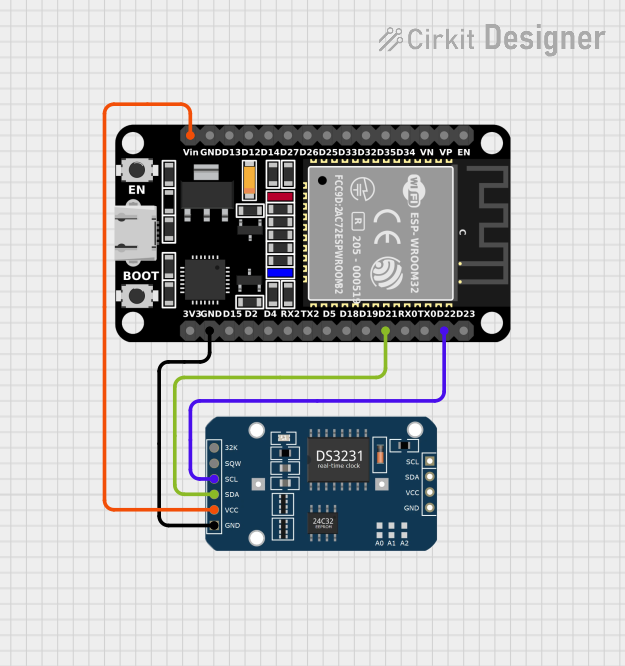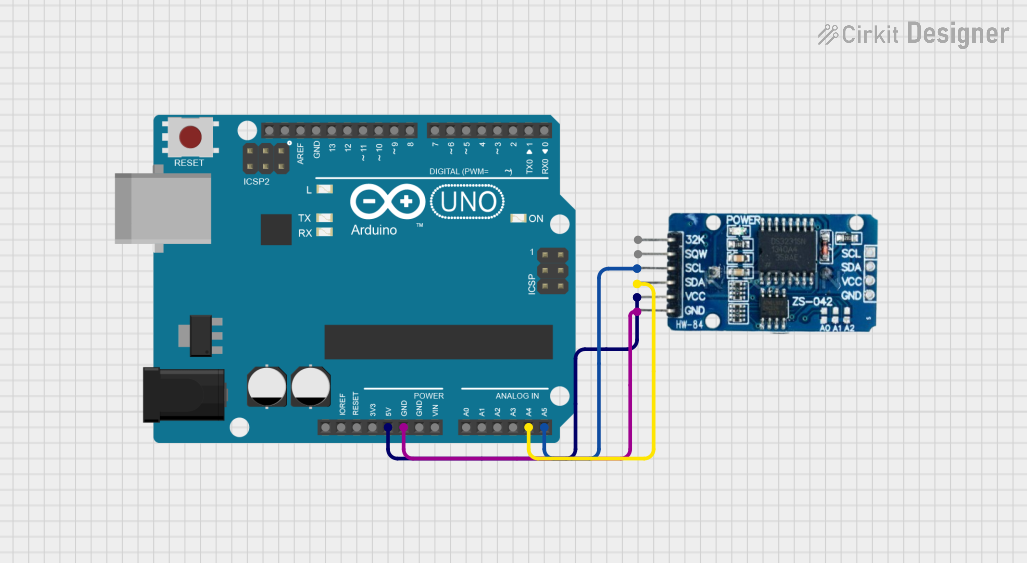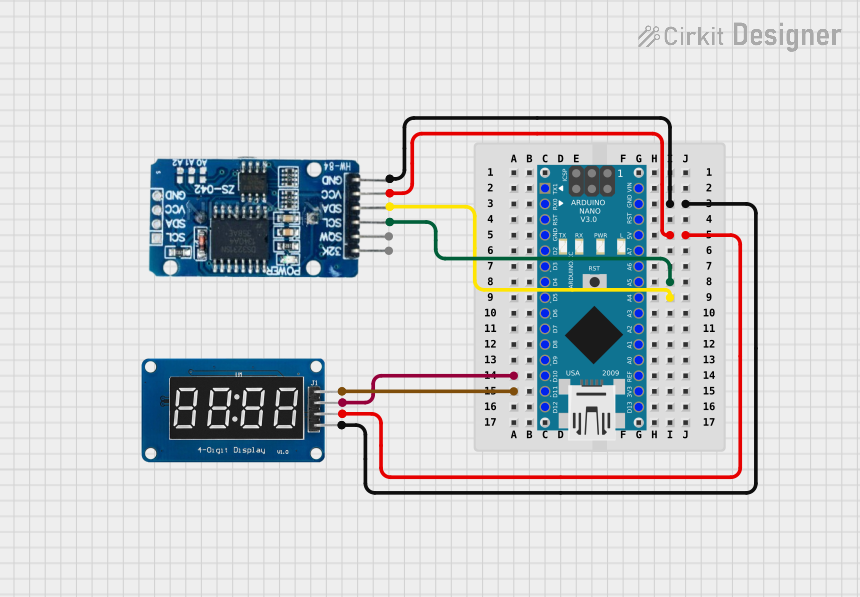
How to Use RTC DS3231: Examples, Pinouts, and Specs

 Design with RTC DS3231 in Cirkit Designer
Design with RTC DS3231 in Cirkit DesignerIntroduction
The Real-Time Clock (RTC) DS3231 is a low-cost, extremely accurate I2C real-time clock (RTC) with an integrated temperature-compensated crystal oscillator (TCXO) and crystal. The device incorporates a battery input, and maintains accurate timekeeping when the main power to the device is interrupted. The integration of the crystal resonator enhances the long-term accuracy of the device and reduces the piece-part count in a manufacturing line. Common applications of the DS3231 include timekeeping for embedded systems, data loggers, time stamps, and other time-critical applications.
Explore Projects Built with RTC DS3231

 Open Project in Cirkit Designer
Open Project in Cirkit Designer
 Open Project in Cirkit Designer
Open Project in Cirkit Designer
 Open Project in Cirkit Designer
Open Project in Cirkit Designer
 Open Project in Cirkit Designer
Open Project in Cirkit DesignerExplore Projects Built with RTC DS3231

 Open Project in Cirkit Designer
Open Project in Cirkit Designer
 Open Project in Cirkit Designer
Open Project in Cirkit Designer
 Open Project in Cirkit Designer
Open Project in Cirkit Designer
 Open Project in Cirkit Designer
Open Project in Cirkit DesignerTechnical Specifications
Key Technical Details
- Time Accuracy: ±2ppm from 0°C to +40°C
- Battery Backup: Yes (typically a CR2032 coin cell battery)
- Operating Voltage: 2.3V to 5.5V
- Operating Temperature: -40°C to +85°C
- Interface: I2C Serial
- Memory: 236 bytes of NV SRAM
Pin Configuration and Descriptions
| Pin Number | Name | Description |
|---|---|---|
| 1 | 32K | 32kHz Output |
| 2 | SQW | Square Wave/Interrupt Output |
| 3 | SCL | Serial Clock Input |
| 4 | SDA | Serial Data Input/Output |
| 5 | VCC | Supply Voltage |
| 6 | GND | Ground |
| 7 | BAT | Battery Input for Any Standard 3V Lithium Cell or Other Energy Source |
Usage Instructions
Interfacing with a Circuit
To use the DS3231 in a circuit:
- Connect VCC to a 3.3V or 5V power supply (depending on your system requirements).
- Connect GND to the ground of your power supply.
- Connect SDA and SCL to your microcontroller's I2C data and clock lines respectively.
- Optionally, connect the 32K pin to an input if you require a 32kHz square wave.
- Optionally, connect the SQW pin to an interrupt input on your microcontroller if you need a square wave or alarm interrupt.
Important Considerations and Best Practices
- Ensure that the I2C bus lines (SDA and SCL) have pull-up resistors, typically 4.7kΩ to 10kΩ.
- Keep the battery connected if you want the RTC to keep time when the main power is off.
- Avoid placing heat-generating components near the DS3231 to prevent temperature-induced inaccuracies.
- Use proper decoupling capacitors close to the VCC pin to filter out noise.
Example Code for Arduino UNO
#include <Wire.h>
#include <RTClib.h>
RTC_DS3231 rtc;
void setup() {
Serial.begin(9600);
// Check if the RTC is connected correctly
if (!rtc.begin()) {
Serial.println("Couldn't find RTC");
while (1);
}
// Check if the RTC lost power and if so, set the time
if (rtc.lostPower()) {
Serial.println("RTC lost power, let's set the time!");
// The following line sets the RTC to the date & time this sketch was compiled
rtc.adjust(DateTime(F(__DATE__), F(__TIME__)));
}
}
void loop() {
DateTime now = rtc.now();
Serial.print(now.year(), DEC);
Serial.print('/');
Serial.print(now.month(), DEC);
Serial.print('/');
Serial.print(now.day(), DEC);
Serial.print(" ");
Serial.print(now.hour(), DEC);
Serial.print(':');
Serial.print(now.minute(), DEC);
Serial.print(':');
Serial.print(now.second(), DEC);
Serial.println();
delay(1000);
}
Troubleshooting and FAQs
Common Issues
- Time Not Accurate: Ensure the battery is installed correctly and has charge.
- I2C Communication Failure: Check the pull-up resistors on the SDA and SCL lines.
- Device Not Found: Verify wiring, ensure correct I2C address is used, and check for soldering issues.
Solutions and Tips
- If the time drifts significantly, consider replacing the battery.
- Use the
rtc.lostPower()function to check if the RTC has lost power and to set the time again if necessary. - For long cable runs, consider using lower value pull-up resistors to maintain signal integrity.
FAQs
Q: How do I set the alarm function on the DS3231?
A: The DS3231 has two alarm functions that can be programmed using the RTClib library. Refer to the library documentation for alarm setup instructions.
Q: Can the DS3231 be used in battery-only mode?
A: Yes, the DS3231 can be powered solely by the battery, but VCC must be connected to a high-impedance state to prevent leakage current from the main supply.
Q: What is the purpose of the 32K pin?
A: The 32K pin outputs a 32kHz square wave that can be used to drive timing circuits or as a clock reference for other devices.